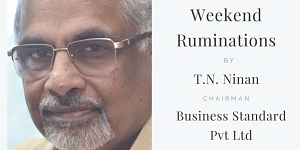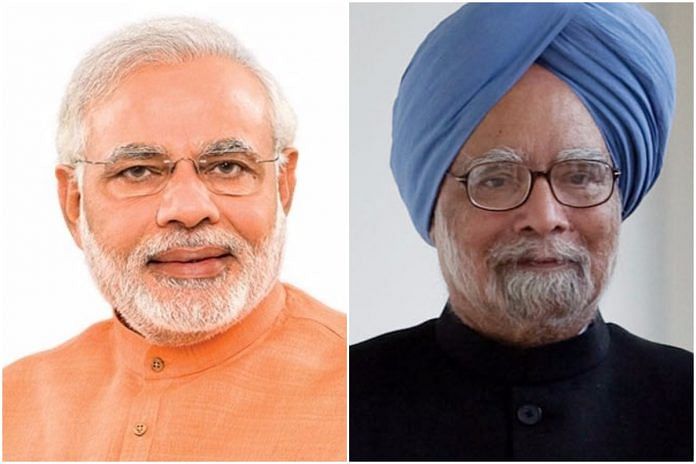The present government scores the same or a little poorer than its predecessor when it comes to governance midway through its first term.
Questions about the record of the Modi government have acquired a new edge, following the economic slowdown. Minimising the importance of the slowdown, at least in his public comments, Mr Modi has sought to emphasise other elements of his record in office — lack of corruption, more effective implementation of programmes, and the like. While the steady stream of economic data permits informed debate on economic growth (regardless, opinions continue to be heavily influenced by political leanings), issues relating to governance quality tend to have fuzzy edges and are more difficult to measure. For instance, are crime statistics a pointer to the fear factor that critics talk of, and is there any way of measuring how much pressure the media is under?
A torch that shines a broad light on some of these issues is provided by Worldwide Governance Indicators, which is available on the World Bank’s database, although the bank and other associated institutions like Brookings have the standard disclaimer that they are not accountable for what the indicators say.
There are six indicators, and 214 economies are scored on each of them every year, using combinations of surveys, opinion polls, individual interviews, consultations with experts and such. This is by definition an imperfect method, and it has no shortage of critics. Still, in the absence of any other torch being available, it might be useful to test the Modi government’s performance on the six indicators (data is available up to 2016), and see what this particular torch shows us.
 The first indicator is control of corruption, and India’s percentile rank (scoring from 0 to 100, a higher score being better) improved sharply from 37.0 in 2013 to 47.1 in 2016. This latter score is not very different from the Manmohan Singh government’s score of 46.8 in 2006, i.e. before the scandals of the second Singh government erupted. Still, a clear plus for Mr Modi here.
The first indicator is control of corruption, and India’s percentile rank (scoring from 0 to 100, a higher score being better) improved sharply from 37.0 in 2013 to 47.1 in 2016. This latter score is not very different from the Manmohan Singh government’s score of 46.8 in 2006, i.e. before the scandals of the second Singh government erupted. Still, a clear plus for Mr Modi here.
On government effectiveness, too, Mr Modi scored well, as India’s rank improved sharply from 45.2 in 2014 to 57.2 in 2016. Here too, it is worth noting that the country ranking in 2007, under Dr Singh, was 57.3 — virtually the same as Mr Modi’s in 2016. Once again, the story is of decline in Dr Singh’s second term, followed by recovery under Mr Modi. Ditto on a third issue, regulatory quality. The Modi government scored well, as India’s rank moved up smartly from 35.1 in 2012 to 41.3 in 2016, but the score was noticeably better in 2006 (45.1).
On political stability and absence of violence, India’s overall rank is surprisingly poor — possibly because of divergence of scores on the two issues. At its best, the country rank was 17.5 in 2005. Other than the fact of a really low score, the pattern is the same. The rank dipped and recovered before hitting 13.8 in 2014. Mr Modi pulled it up to 17.1 in 2015, but then saw the rank dip to 14.3 in 2016 — lower than in 2005. Remember that there was an upsurge of protest in Kashmir in 2016, as also a 21 per cent increase in bomb blasts in Maoist-controlled areas, according to the official statistics. On the internal security front, the Modi government clearly suffered a setback in 2016.
It is on the final two indicators that the pattern changes completely. On rule of law, the country’s rank in 2016 (52.4) was marginally lower than in 2013 (53.1), and significantly lower than in 2006 (58.4). And on the sixth and final indicator, voice and accountability, it is no surprise that the Modi government does not do very well, with India dipping from a rank of 61.5 in 2013 to 58.6 in 2016.
Overall, the Modi government has three clear pluses, two negatives and one that scores par or as a qualified plus — all of them when compared to the years immediately before the 2014 election. But the pattern also is that the present government has scored about the same or poorer than its predecessor did midway through its first term.







Good article. Just one observation. Dr. MMS did inherit a much better India in 2004 than PM Modi did in 2014.
The only provision in the Constitution in which the People of India in stipulating Directive Principles of State Policy refer to “governance” is Article 37. In the Indian context good governance would mean governance consistent with the Directive Principles stipulated in Part IV of the Constitution without the Courts having to intervene in decision-making. In other words, it would be governance in strict compliance of Part IV without contravening any provision in the Constitution outside Part IV. Ruling in compliance with Article 37 leads to governance in accordance with the Rule of “Law ” referred to in that Article. It is indeed a challenge to govern without listing any statute in Schedule IX, Other parameters pale in significance.
THE ECONOMY OF THE COUNTRY HAS GONE TO THE DOGS UNDER THE PRESENT GOVT. THIS GOVT. HAS GIVEN THE COUNTRY :
1. INCREASE IN BLACK MONEY REGENERATION.
2.HEAVY JOB LOSSES .
3.SUBSTANTIAL INCREASE IN CROSS BORDER TERRORISM.
4.FEEDING THE GOVT. PARASITES WITH 7thPAY COMMISSION.
8.FALSE PROMISES—WITH LPG SUBSIDY BEING WITHDRAWN.
9. KILLING THE SENIOR CITIZENS BY CUTTING DOWN BANK DEPOSIT INTEREST RATES.
10.INCREASED CORRUPTION.
11.POLITICIANS & THE CORRUPT GETTING RICHER& RICHER.
12.KILLING THE POOR TO ERADICATE POVERTY.
13.REIGNING IN OF THE YOUNGER DEVIL STEP BROTHER-IN-LAW GST. WITHOUT CONSULTING THE EXPERTS.
14.THE PRESENT RULERS HAVE NO MORAL RIGHTS TO CONTINUE IN OFFICE.
” GOD HAVE MERCY ON THE COUNTRY & ITS PEOPLE. “
If you don’t do anything, you won’t make any mistakes. Then you can say you havent taken any wrong step. It’s as simple.as that. I haven’t come across a single constructive article so far which actually evaluate the pros and cons. As always we are always busy putting on cloud 9 or criticism to the core. There is not much hope with this sort of journalism/mentality. I don’t understand one thing – there is so much hurry and cry about bringing back black money, but why no one talks about so many gates (coal gate, etc) now, corruption that has taken place? Is it not relevant anymore? Let bygones be bygones? I think we have seen enough of this systematic dismantle of the country and the system. Ateast Modi tried to bring back black money, did anyone else even tried? So, trying and failing is more problematic than not trying at all. I don’t think ppl of this country are dumb, they will figure this all out
What about the intangible factors like widening gap between religious groups, breaking the social fabric and harmony, movement towards a theocratic state.
i am amazed that the left intellect has given credit to modi. conveniently he has taken the starting point which suits. Ideally india was ruled for more than 60years by fraud ghandhy / nehru dynasty. Conveniently he has not spoken about loot by the upa in the last 10 years. 9 lac crores of bank losses after nationalization. Credit growth story by recycling loan on books to show less npa or manage npa etc… which modi is trying to take the bull by horn to resolve.
Biggest turnaround : from scam ridden, cash fuellled parallel economy to a honest Governance, & fair business environments. May be some unfavourable indictor but in long run India will grow fast.
Good analysis,2019 will be not cakewalk 4 bjp, now voters know fact and Jumla difference